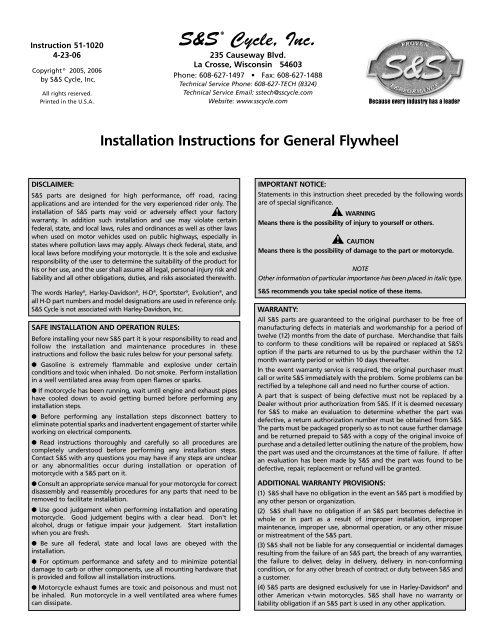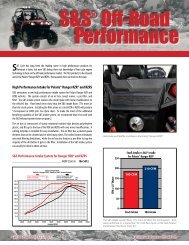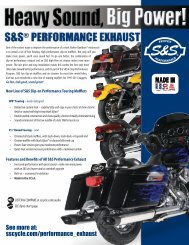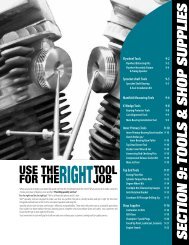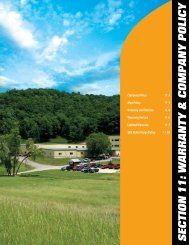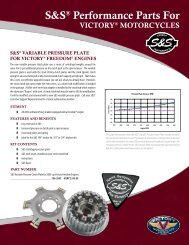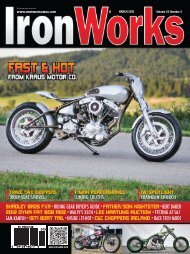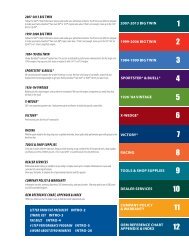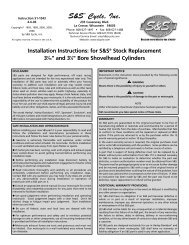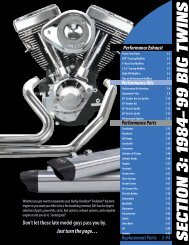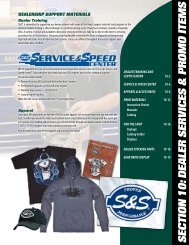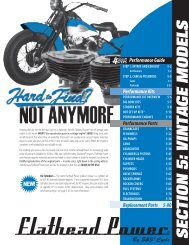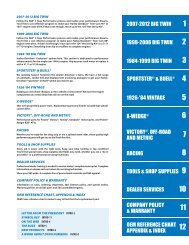Installation Instructions for General Flywheel - S&S Cycle
Installation Instructions for General Flywheel - S&S Cycle
Installation Instructions for General Flywheel - S&S Cycle
You also want an ePaper? Increase the reach of your titles
YUMPU automatically turns print PDFs into web optimized ePapers that Google loves.
CAUTIONS&S ® warranty is void if flywheel tapers are lapped.E. Check keys in groove of shafts. Keys should be lighthand press fit in grooves. If key is too tight in groove,sand side key with fine sand paper on a metal plate orother flat surface. Do not hammer key into groove.CAUTIONHammering tight key into groove may result in irreparabledamage to shaft.F. With key in shaft, insert into respective tapered hole inflywheel and check to see that key does not bottom ingroove. If key bottoms out, file flat side of key, notrounded side, until shaft with key in place fits inflywheel without bottoming out. Check crankpin andcrankpin key also.3. Lower End AssemblyA. Reclean mainshaft tapers, crankpin and flywheel taperswith lacquer thinner.B. Assemble mainshafts in respective flywheels. Lightlycoat taper and threads of each shaft with greenLoctite ® during assembly. Install crankpin in camsideflywheel using Loctite ® also. Refer to table below <strong>for</strong>torque specifications.CAUTIONIf stock torque specs are exceeded with stock mainshaftsdamage to the mainshaft may result. <strong>Flywheel</strong>s orconnecting rod bearings damaged as a result of blocked oilpassageways that were not checked during assembly are notcovered under warranty.C. After camside flywheel, pinion shaft and crankpin areassembled, blow air through pinion shaft oil feed hole tocheck <strong>for</strong> blockage or misalignment of oil feed passages.CAUTIONPartially or completely blocked oil feed passageways maycause irreversible damage to connecting rod bearings andother engine components.D. Measure width of female rod on crankpin end. SeePicture 2. Measurement should be 1.743"-1.745" <strong>for</strong> bigtwins, and 1.481"-1.483" <strong>for</strong> Harley-Davidson ®Sportster ® models.S&S ® FLYWHEEL ASSEMBLY TORQUE SPECIFICATIONSStock Harley-Davidson ®ShaftsS&S Shafts(Street)S&S Shafts(Racing)Picture 2BIG TWINSprocket Shaft 290-320 400-450 450-0005Pinion Shaft 140-170 275-300 275-300Crankpin Nut 180-210 350-400 450-500SPORTSTER ®MODELE. A pre-assembly connecting rod side play check shouldbe done be<strong>for</strong>e final assembly to determine ifconnecting rod side play will fall within the specified.015"-.035" range when crankpin nuts are finaltightened. Assemble left and right flywheels oncrankpin without rods. Moderately snug crankpin nuts.Do not worry about flywheels being true. Measuredistance between connecting rod thrust pads onflywheels. See Picture 3.Sprocket Shaft 100-120 340-360 350-400Pinion Shaft -Pre-1985Sportster ® ModelsPinion Shaft -1985-UpSportster ® Models100-120 180-200 200-250100-120 340-360 350-400Crankpin Nut 150-075 290-310 350-400** Using S&S sprocket shaft nut on crankpin.4Picture 3
Rod side play will be reduced by about .015" whencrankpin nut is final tightened. There<strong>for</strong>e, distancebetween flywheel thrust pads as measured in this checkmust be .030"-.050" greater than female rod widthmeasured in step D. For example, if a big twin femalerod measures 1.744", the distance between flywheelpads must be 1.774"-1.794". If difference between padto pad distance and female rod width is less than .030",female rod must be surface ground on sides to providemore clearance. Take equal amounts off each side ifmore than .010" is to be removed. If more than .050"must be removed from female rod width or if differencebetween pad to pad distance and female rod width isgreater than .050" a different crankpin should be tried.If side play is incorrect and different crankpins do notcorrect problem, contact S&S ® .NOTE: S&S recommended rod side play is .015" to .035". Ifmaterial is removed from sides of female rod, overall width ofbearing cages must be reduced so bearings and cages are free tofloat with rods without contacting flywheel thrust pads. Bearingcage side clearance of .008 to .020 less than rod width isrecommended.NOTE: When truing flywheels, runout measurements must betaken on mainshaft bearing surfaces. Do not take measurementson flywheel rims. <strong>Flywheel</strong> rim will show runout that is not avalid indication of mainshaft concentricity.CAUTIONIf it is necessary to strike the rim of the flywheels during thetruing procedure, a lead hammer should be used to avoiddamaging the flywheel rim. If rim is dented it may beimpossible to recondition mainshaft tapers due to difficultiesindicating center of taper.4. <strong>Installation</strong>A. For engines of 4 1 ⁄2" or longer stroke, the oil return holesin the stock location must be plugged, and thecrankcase must be modified to use the lowered oilreturn holes. This modification is necessary due toincreased piston travel in longer stroke engines. Oilcontrol ring position will be below stock cylinder oilreturn hole at the bottom of the stroke. If modificationis not done, oil will be carried to the combustionchamber by piston rings causing engine to smoke.●●CAUTIONIncorrect connecting rod side play may cause excessiverod side thrusting and potential damage to rods,flywheels and other engine components.Connecting rod bearing and cage assemblies that arewider than female rod may become damaged uponcontact with flywheel thrust pads. Abrasive particlesfrom damaged rod bearings may circulate in oil and causedamage to other engine parts.J. Finish assembling flywheels and rods. See S&S <strong>Flywheel</strong>Assembly Torque Specification table. Check finalconnecting rod side play with feeler gauge.K. Check flywheel assembly <strong>for</strong> run out by placing ends ofmainshafts between centers. Place dial indicators onbearing surfaces of mainshafts. True wheels as needed.S&S trues flywheel assemblies to .0005" or less runouton either mainshaft bearing surface. See Picture 4.NOTE: Engines with strokes shorter then 4 1 ⁄2" stroke or shorter donot require this step.1. If using stock cylinder base gaskets, place basegasket on cylinder base gasket surface, and punch1⁄ 4" hole in gasket directly in center of oil returnhole in base gasket surface of cylinder. S&S gasketsare pre-punched.2. Place gasket on driveside crankcase half in itsrespective position. Mark crankcase gasket surfacethrough 1 ⁄4" diameter hole in gasket.3. Drill 1 ⁄4" diameter hole perpendicular into crankcasegasket surface 5 ⁄8" deep. See Figure 2.Figure 24. Per<strong>for</strong>m Steps 1 through 3 on other cylinder.5. Bolt the front and rear cylinders on drive sidecrankcase half.Picture 45
6. Using lower oil return hole in cylinder spigots as aguide, drill 1 ⁄4" diameter connecting holes incrankcase to intercept holes drilled 5 ⁄8" deep in Step3. See Figure 2 and Picture 5. Driveside crankcaseDrill 1 ⁄4" diameter hole, 5 ⁄8" deepPicture 5NOTES● If base plates are to be used, be sure they are in place.● Lower oil return hole in current production S&S ® cylinders is1⁄2" on center below base gasket surface of cylinder. Thisdimension allows the use of up to 5" stroke using a 1 ⁄8" thickbase plate. Some early production cylinders have lower oilhole located about 5 ⁄16" on center below gasket surface.These early production cylinders can be used with strokes upto 4 3 ⁄4" where base plates are not used.●●●S&S big twin flywheels can be ordered machined to stock8 1 ⁄2" diameter or to small diameter (typically 8 1 ⁄4"). Smalldiameter flywheels are used mainly to provide extra pistonto flywheel clearance thus allowing the use of longer skirtedpistons in long stroke engines. There is also about a 2 pounddifference in weight between stock and small diameterflywheels. It is important to modify crankcases to acceptflywheels to be used. <strong>Flywheel</strong>s that are too small will leavea large gap between flywheels and oil scraper resulting inpoor oil scavenging and possible oil consumption problems.If flywheel diameter is smaller than diameter crankcaseswere machined to accept, scraper should be built up to rimof flywheels. Recommended clearance between flywheelsand scraper is .008" - .010".When sealing crankcase halves, S&S recommends use of hightemp resistant RTV premium silicone sealant or Hylomarsealant. Use any sealant sparingly to prevent particles ofexcess material from entering crankcase and potentiallygetting into engine oil.After flywheel assembly is installed in crankcases, rods must bechecked <strong>for</strong> straightness. S&S Rod Checking Pin, Part 53-0002,was designed to help per<strong>for</strong>m this procedure. It may also benecessary, to fabricate a rod bending tool as illustrated inFigure 3. The purpose of this procedure is to correct <strong>for</strong>machining tolerance discrepancies in components which maylead to pistons not running true in cylinder bores. While rodsmay be straight and true, it is sometimes necessary, to bendthem to correct <strong>for</strong> these machining discrepancies. Do notbend rod by using tool in wristpin hole as this method maydistort wristpin bushing. We also feel that using a piston inlieu of a checking pin may prove inaccurate due to variationsin lengths of piston skirts from one side of piston to the other.B. Clean dirt, filings, etc. out of passageways.C. Press a piece of 3 ⁄4" long x 3 ⁄8" O.D. steel tubing (Part93-1032) provided in kit into oil return hole in basegasket surface until tubing is flush with surface.Ream hole slightly with drill to remove any burrs thatmay exist.NOTE: A very tight press fit with 100% seal is not critical as tubewill sufficiently divert oil flow to new hole. Loctite ® may beapplied to tube if fit seems too loose.5. <strong>Installation</strong> Notes●●When pressing Timken ® bearings on sprocket shaft, be sureto lubricate the shaft. If this is not done the bearing may gallon the shaft and become stuck.Big twin engines using 1958 and later style pinon shaftsmay be assembled with any of the different styles ofpinon main bearing sets <strong>for</strong> 1958 and later engines. Ifnecessary, bearings can be spaced with thrust washers tocontrol end play and to insure that rollers run fully withinthe bearing race.Figure 3CAUTIONPistons which do not run true in cylinder bores may causeexcessive connecting rod side thrusting. This in turn may leadto premature ring, piston, connecting rod and rod bearingwear and eventual failure of these parts.6
Checking Connecting Rod StraightnessA. Insert checking pin into wristpin hole. Place strips of paperbetween checking pin and crankcase cylinder gasket surfaceand apply slight downward pressure to wristpin end of rodby rotating flywheels. Pull papers out slowly. Drag on papersshould be equal.B. Rotate flywheels in opposite direction until checking pincontacts cylinder gasket surface again. Repeat procedure torod again. If drag on papers is equal no bending is required.If one paper is loose, use rod bending tool to tweak rod indirection of loose paper and recheck. See Picture 6.C. Repeat checking and bending procedure <strong>for</strong> other rod.Picture 6FLYWHEEL IDENTIFICATIONStyle, stroke, and diameter of S&S ® flywheels can be determined by examining the serial number which is stamped on therim of both flywheels in the set. Usually the flywheel serial number can be read through the timing plug hole of anassembled engine. Press-together flywheel serial numbers are stamped on the inside rim of S&S flywheels. A cylindermust be removed in order to read serial number.Year of Serial <strong>Flywheel</strong> Engine <strong>Flywheel</strong>Manufacture Number Stroke Style DiameterS1234-3 SLXBig twin engine style codesBig twin stroke codesFour cam style codesFour cam stroke codesCodeStrokeCodeStrokeCodeStrokeCodeStrokeE 1936-1954L 1955-1971AL 1972-Early 1981SE* 1955-Early 1981BL Late 1981-UpSL* Late 1981-UpJEarly Delkron4 cam casesJLLate Delkron4 cam casesHEarly McClure4 cam casesHLLate McClure4 cam cases1 4- 3 ⁄8"2 4- 1 ⁄2"3 4- 3 ⁄8"4 5"5 4- 1 ⁄4" (Stock 80")6 4- 5 ⁄8"12 5 1 ⁄4"13 3- 1 ⁄2" (Stock 61")14 3- 31 ⁄32" (Stock 74")16 5- 1 ⁄8"None 1957-1976B 1957-Early 1981SB* 1957-Early 1981BD† 1977-Early 1981SBD*† 1977-Early 1981C Late 1981-1985SC* Late 1981-1985SCD*† Late 1981-1985SCDR*†‡ Late 1981-1985D§ 1986-UpDRS§†‡ 1986-Up1 4- 1 ⁄16"2 4- 3 ⁄16"3 4- 5 ⁄16"4 4- 7 ⁄16"6 4- 5 ⁄8"7 4- 13 ⁄16"8 5"11 4- 1 ⁄2"12 5- 1 ⁄4"15 3- 13 ⁄16" (Stock)16 5- 1 ⁄8"* <strong>Flywheel</strong>s machined <strong>for</strong> special S&S sprocket shaft and stock pinion shaft.§ <strong>Flywheel</strong>s machined <strong>for</strong> special S&S pinion and sprocket shafts.† <strong>Flywheel</strong> machined to use either 1977 to 1986 style Torrington main bearing or 1987 and later style caged roller pinion shaft mainbearing assembly.‡ Machined <strong>for</strong> use with 1986 and later stock xl connecting rod bearings.7
Because every industry has a leader


